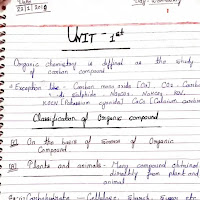Organic Chemistry 1 - Unit 1 PDF Download
Download this PDF to study the fundamental concepts of Organic Chemistry, Unit 1. Covers Classification, Nomenclature, and Isomerism.
Keywords: Organic Chemistry, Classification, Nomenclature, Isomerism, IUPAC, Common Nomenclature, Structural Isomers, PDF Download, Chemistry Notes, Unit 1.
Understanding Organic Chemistry: Classification, Nomenclature, and Isomerism
Organic chemistry, the study of carbon-containing compounds, forms the basis of understanding life itself. This first unit introduces the fundamental building blocks and principles that govern the behavior of organic molecules. Let's delve into the core concepts of classification, nomenclature, and isomerism.
Classification of Organic Compounds
Organic compounds are incredibly diverse, and classifying them helps us organize and understand their properties. The primary classification revolves around the functional groups present in the molecule. A functional group is a specific atom or group of atoms within a molecule that is responsible for its characteristic chemical reactions. Common functional groups include alcohols (-OH), aldehydes (-CHO), ketones (-CO-), carboxylic acids (-COOH), amines (-NH2), and alkenes (C=C). Compounds are categorized based on the presence of these functional groups. For example, a compound containing an -OH group is classified as an alcohol. Beyond functional groups, organic compounds can also be categorized based on their structure: aliphatic (open chain), alicyclic (cyclic but not aromatic), and aromatic (containing a benzene ring). This initial classification is the foundation for predicting how these compounds will behave chemically.
Common and IUPAC Systems of Nomenclature
Naming organic compounds is crucial for clear communication. Two primary systems exist: the common system and the IUPAC (International Union of Pure and Applied Chemistry) system. The common system often uses historical names or names based on the source of the compound. For instance, acetic acid was named so because it's derived from vinegar (acetum in Latin). While useful for simpler molecules, the common system becomes ambiguous and unwieldy for more complex structures. This is where the IUPAC system shines.
The IUPAC system is a systematic, rule-based approach to naming organic compounds. It starts by identifying the longest continuous carbon chain in the molecule, which forms the "parent chain." This chain is then numbered, and substituents (atoms or groups of atoms attached to the parent chain) are identified and named. The position of each substituent is indicated by the number of the carbon atom to which it's attached. Prefixes, suffixes, and numbers are combined to create a unique and unambiguous name for each compound. This unit focuses on compounds containing up to 10 carbons in open chains and carbocyclic (cyclic compounds containing only carbon atoms) structures, providing a solid foundation for mastering IUPAC nomenclature.
Structural Isomerism
Isomers are compounds that have the same molecular formula but different structural arrangements of atoms. Structural isomers, specifically, differ in the connectivity of atoms. This means the atoms are bonded together in different sequences, leading to different physical and chemical properties. Several types of structural isomerism exist:
- Chain Isomerism: This occurs when the carbon skeleton of the molecule is arranged differently, leading to different branching patterns. For example, butane (C4H10) has two isomers: n-butane (a straight chain) and isobutane (a branched chain).
- Position Isomerism: This occurs when the position of a functional group or a substituent changes within the molecule. For example, 1-propanol and 2-propanol both have the formula C3H8O, but the -OH group is attached to different carbon atoms.
- Functional Group Isomerism: This occurs when the same molecular formula can represent different functional groups. For example, ethanol (C2H6O) and dimethyl ether (C2H6O) are functional group isomers, with ethanol being an alcohol and dimethyl ether being an ether.
Understanding structural isomerism is essential because isomers, despite having the same molecular formula, can exhibit vastly different properties and reactivities. This difference stems from the distinct spatial arrangement and connectivity of atoms within the molecule.
By grasping these fundamental concepts of classification, nomenclature, and isomerism, you'll build a strong foundation for exploring the more complex and fascinating world of organic chemistry. Download the provided PDF to solidify your understanding and practice applying these principles.
Info!
If you are the copyright owner of this document and want to report it, please visit the copyright infringement notice page to submit a report.

